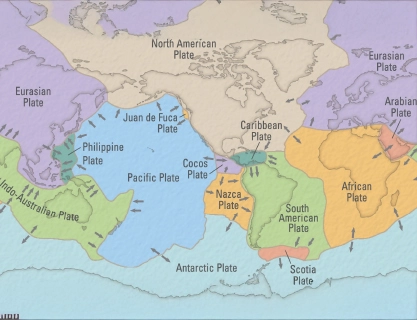Shoubik Suri
Earth is a planet in perpetual motion, its surface never truly static. Beneath the seemingly stable ground, immense tectonic forces are at work, moving continents, shaping mountains, and driving geological processes that have profound impacts on the planet’s environment and life. These tectonic shifts have sculpted Earth over billions of years, creating the landscapes we see today and influencing the evolution of life. Understanding the history of these movements, the methodologies used to study them, and their future implications is critical for predicting their consequences and mitigating the risks they pose.
The story of tectonic shifts begins billions of years ago, when Earth’s surface cooled and fractured into a mosaic of rigid plates. Floating on the semi-fluid mantle beneath, these tectonic plates are driven by convection currents powered by the planet’s internal heat. Over time, these plates collided, separated, and reshaped the planet, forming continents, oceans, and mountain ranges. This dynamic process has profoundly influenced Earth’s history, climate, and biodiversity.
The exact timing of the onset of plate tectonics is debated, but evidence suggests that tectonic activity may have started as early as 3.2 to 3.8 billion years ago, during the Archean Eon. Ancient rocks, such as the Isua Greenstone Belt in Greenland and the Pilbara Craton in Australia, provide clues about the early movement of Earth’s crust. These rocks contain mineral structures and isotopic signatures that suggest the presence of subduction processes—a hallmark of plate tectonics.
During the Archean, the Earth’s crust was thinner and more pliable than today, leading to smaller and more dynamic plates. The first proto-continents formed as volcanic activity and plate collisions gradually built up landmasses. Unlike modern continents, these early landmasses were smaller, less stable, and frequently recycled into the mantle due to intense tectonic and volcanic activity.
By the Proterozoic Eon (2.5 billion to 541 million years ago), tectonic activity had matured. Throughout Earth’s history, the movement of tectonic plates has followed a cyclical pattern of forming and breaking apart supercontinents. Rodinia, one of the earliest supercontinents, existed over a billion years ago and played a role in stabilising the planet’s climate. Later, Pangaea, which formed around 335 million years ago, united all major landmasses into a single giant continent. Its eventual breakup during the Mesozoic era gave rise to the modern continents and the Atlantic Ocean. The collisions and separations of tectonic plates during these periods not only created the physical geography of the planet but also influenced the distribution of species and ecosystems.
Tectonic activity has continued to shape the planet in recent geological history. The collision of the Indian and Eurasian plates formed the Himalayas, the world’s tallest mountain range, which continues to rise as the plates converge. Similarly, the Mid-Atlantic Ridge, where the Eurasian and North American plates are drifting apart, is a site of continuous oceanic crust formation. The Pacific Ring of Fire, a tectonically active region encircling the Pacific Ocean, is home to frequent earthquakes and volcanic eruptions, making it one of the most geologically volatile areas on Earth.
Looking ahead, the movements of tectonic plates will continue to transform the planet over millions of years. Geologists predict that a new supercontinent will eventually form as continents converge once again. Scenarios such as Pangaea Proxima, Amasia, or Novopangaea suggest different configurations of landmasses, depending on the direction and speed of plate movements. These shifts will have profound implications for Earth’s climate, ocean currents, and ecosystems. For example, the closure of the Atlantic Ocean or the shrinking of the Indian Ocean could alter global wind and weather patterns, while the formation of new mountain ranges will create fresh habitats and influence regional climates.
To understand and predict these changes, scientists rely on a range of advanced methodologies. Global Positioning Systems (GPS) allow precise measurements of plate movements, often down to millimeters per year. Seismic data from earthquakes provide insights into plate boundaries and the processes occurring beneath the surface. Paleomagnetic studies, which examine the magnetic properties of rocks, help reconstruct the movements of plates over millions of years. Modern technologies such as satellite imaging and geophysical surveys, including seismic tomography and gravity mapping, offer detailed views of Earth’s crust and mantle, enabling researchers to better understand the forces driving tectonic activity. Scientists have measured the Indian Plate’s movement toward the Eurasian Plate at a rate of about 5 centimetres per year, driving the uplift of the Himalayas.
Seismology is a cornerstone of tectonic research. Seismometers record vibrations caused by earthquakes, which occur when stress along faults or plate boundaries is suddenly released. By analysing seismic waves, researchers can map plate boundaries and study the structure of the Earth’s interior. Seismic tomography, a technique akin to medical CT scans, uses earthquake wave data to create three-dimensional images of the mantle, revealing features like sub-ducting slabs and mantle plumes.
Paleomagnetism, the study of the magnetic properties of rocks, provides a window into the past movements of tectonic plates. When volcanic rocks form, magnetic minerals within them align with Earth’s magnetic field. Evaluating the orientation of these minerals, scientists can reconstruct the positions of continents and track plate movements over millions of years. For instance, paleomagnetic studies have been instrumental in understanding the breakup of Pangaea and the opening of the Atlantic Ocean.
Deep drilling projects, such as the International Continental Scientific Drilling Program (ICDP), provide direct access to rock samples from tectonic boundaries and fault zones. These samples allow scientists to study the physical and chemical properties of Earth’s crust and better understand the mechanics of plate movements.
Recent research in tectonics has focused on subduction zones, where one plate sinks beneath another, as these are critical sites for earthquakes and volcanic eruptions. In regions like the Cascadia Subduction Zone in North America, scientists are studying the potential for a massive earthquake. Other studies have highlighted the role of water in the mantle, which affects the speed and dynamics of plate movements. Advances in artificial intelligence and machine learning are also revolutionising the field by analysing vast datasets from seismic stations and satellite observations, improving predictions of tectonic activity.
The consequences of tectonic shifts are far-reaching, both in the natural world and for human societies. Earthquakes and volcanic eruptions remain significant hazards, particularly in densely populated regions near active plate boundaries, such as Tokyo, Istanbul, and Los Angeles. The rising of mountain ranges and the shifting of oceans will continue to shape habitats and influence the evolution of species. These geological processes also have profound implications for human infrastructure, agriculture, and trade routes, underscoring the importance of preparedness and adaptation.
Tectonic shifts also play a critical role in regulating Earth’s climate. The movement of plates affects the carbon cycle by cycling carbon between the surface and the interior of the planet. Volcanic eruptions release carbon dioxide into the atmosphere, while the burial of organic material in subduction zones sequesters carbon over long timescales. These processes have influenced Earth’s climate throughout its history and will continue to do so in the future.
The history of tectonic shifts reveals a dynamic and ever-changing Earth, shaped by powerful forces beneath the surface. From the formation of ancient supercontinents to the ongoing drift of modern plates, these movements have played a central role in shaping the planet’s landscapes, climates, and ecosystems. Advances in geophysical research are providing unprecedented insights into these processes, enabling scientists to predict future changes and mitigate risks. As humanity continues to live on this dynamic planet, our ability to understand and adapt to tectonic shifts will be crucial for ensuring a sustainable and resilient future.
The study of tectonic shifts is not merely academic; it has profound implications for society. Understanding plate tectonics helps mitigate the risks associated with earthquakes, tsunamis, and volcanic eruptions, which pose significant threats to millions of people living near tectonic boundaries. Moreover, tectonics play a critical role in shaping Earth’s climate. By cycling carbon between the surface and the mantle, tectonic processes regulate greenhouse gas levels and influence long-term climate trends. This understanding is vital for modelling Earth’s future climate and assessing the impacts of human activity.






